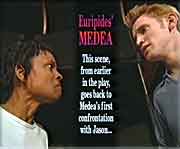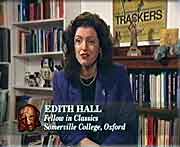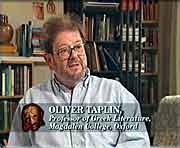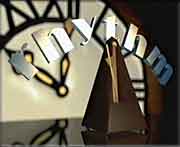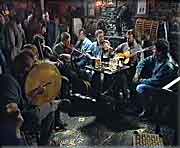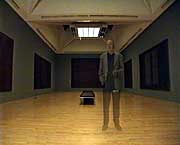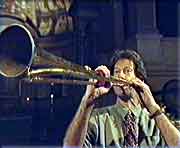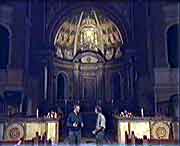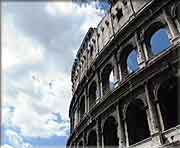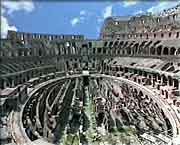|
BBC / Open University Programmes
AN INTRODUCTION TO THE HUMANITIES (A103) - 1998 onwards
Produced and Directed by Tony Coe:
- FRAMING AND FORMING (TV1)
This programme featured Charles Harrison investigating the making of Jackson Pollock's Summertime and the ways it's subsequently been framed by the Art Establishment. Shot on location in a single day in the Tate Gallery in London, with original graphics to help reconstruct how Pollock put the picture together, the programme makes a powerful case for treating Pollock's Abstract Expressionist art seriously, however casually constructed it may appear.
- EURIPIDES' MEDEA (TV20)
Fiona Shaw, working with a group of mature students, explores how to make this most unnaturally violent play work for a modern audience. The parallels might be obvious - Moors murderers, the Wests - but how can we possibly empathise with Medea's dilemma when the consequences are so appalling. An object lesson in how to find your way to the heart of a play, shot as it happened, over two days in the Greenwich Theatre.
- GENDER IN ART (TV24)
What happened to women in art... or rather what happened to women artists? Women in art ended up inside the frame, painted there by men, but women artists before 1850, well what about the absolutely fascinating Sophonisba Anguissola, and one painting in particular by her. It's in Siena and it's supposed to show Sophonisba's portrait being painted by her teacher - Bernardo Campi - so it's her painting him painting her... only x-rays have begun to suggest an even more devious twist in the story of this remarkable picture.
- ROTHKO (TV29)
Wrist slitting depths of depression or quiet uplifting spirituality, Rothko's sombre canvasses provoke extreme reactions, but as Charles Harrison points out, whatever else they do, Rothko's abstract paintings like the Seagram Mural series, do fit into the tradition of western art, exemplified by Rembrandt. He also identifies good and bad ways of viewing pictures, or at least ways of giving pictures a real opportunity to work on you.
- GETTING IT RIGHT (TV30)
For five days in the bright sweltering summer heat of Indiana USA, 13 people cut, beat, hammer, solder, coax, cajole and swear as they try to make a natural trumpet of their own, just the way it used to be done before electricity and mass production. They start with flat metal cutouts and by the end... Well you have to watch to see, and hear the results. It's all part of the authentic music revival that began in the 60s as a radical departure from convention...
Produced and Directed by Mags Noble
- MUSIC TO THE EAR (TV3)
When I'm 64 by the Beatles, released in 1967, seems a simple song, but looks can be deceptive. There's actually a lot going on musically which is why the song lends itself so well to the investigation of the 3 basics of music. Steve Reich and his Clapping Music help explore rhythm, while Johnnie McCarthy and the loose affiliation of musical regulars from the Spaniard Inn provide the melodies and Japanese composer Takemitsu demonstrates timbre.
- THE EMPEROR'S GIFT: THE COLOSSEUM (TV5)
When was the Colosseum in Rome built and for what purpose? This programme examines not only the history of one of Rome's most dramatic landmarks, but also why the architectural design of the Colosseum is an ideal model for modern stadiums.
- VENUE OF LEGENDS: WEMBLEY STADIUM (TV6)
Whether sports fanatic or not, most people would recognise the twin towers of Wembley - the one feature many hoped would survive the rebuilding of the stadium in the millennium. This programme explores Wembley Stadium as an architectural case-study and shows that to fully understand the form and function of the building, you also need to know its history - when and why was the stadium erected at Wembley and why the echoes of the Roman Colosseum?
- THE MYTH OF MEDEA (TV21)
This programme explores the tension between ancient and modern dramatic performance conventions which is inherent in attempts to recreate Euripides' Greek tragdey, Medea. Taking a number of aspects of Greek drama - the space in which the plays were originally performed, the language used, performance convention, the audience - the programme examines how so-called authentic elements are assimilated, rejected or transformed in modern productions.
Featuring interviews with Oliver Taplin and Edith Hall; extracts from the Ninagowa "Medea" & the National Theatre production of the "Orestia".
- MYTH AND MUSIC (TV22)
Folklore is full of stories about people who suddenly disappear from home or who are stolen by the fairies. Traditional Scottish myths such as these have appealled to the composer, Judith Weir, for some years. Between 1982-1990 she wrote four works based on "disappearance" stories and here we explore how myth and music may interact, and how a myth may be reworked, both by storytellers and by muscians. The four pieces of music featured are:
-Bonnie James Campbell from Scotch Minstrelsy;
-The Song of the Girl Ravished Away by the Fairies of South Uist - from Songs of the Exotic;
-Distance and Enchantment;
-The Vanishing Bridegroom.
The programme was predominantly shot on location in the Uists.
|

